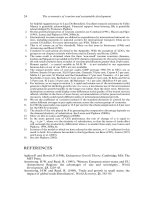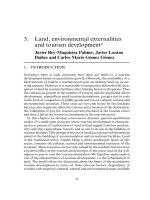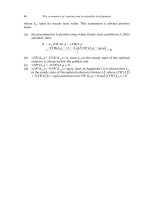THE ECONOMICS OF MONEY,BANKING, AND FINANCIAL MARKETS 436
Bạn đang xem bản rút gọn của tài liệu. Xem và tải ngay bản đầy đủ của tài liệu tại đây (32.69 KB, 1 trang )
CHAPTER 16
The Money Supply Process
LE A RNI NG OB J ECTI VES
After studying this chapter you should be able to
1. summarize the Bank of Canada s balance sheet and the monetary base
2. discern who controls the monetary base and what causes it to change
3. explain how the banking system creates deposits
4. utilize a simple model of multiple deposit creation, showing how the central
bank can control the level of deposits by setting the level of reserves
PRE VI EW
As we saw in Chapter 5 and will see in later chapters on monetary theory, movements
in the money supply affect interest rates and the overall health of the economy and
thus affect us all. Because of its far-reaching effects on economic activity, it is important to understand how the money supply is determined. Who controls it? What
causes it to change? How might control of it be improved? In this and subsequent
chapters we answer these questions by providing a detailed description of the money
supply process, the mechanism that determines the level of the money supply.
Because deposits at banks are by far the largest component of the money supply, understanding how these deposits are created is the first step in understanding the money supply process. This chapter provides an overview of how the
banking system creates deposits. In addition, it outlines the basic building blocks
needed in later chapters for you to understand in greater depth how the money
supply is determined.
THRE E P LAYE RS I N T HE M O NE Y SU PP LY P ROC ESS
The cast of characters in the money supply story is as follows:
1. The central bank the government agency that oversees the banking system and
is responsible for the conduct of monetary policy; in Canada, the Bank of Canada
2. Banks (depository institutions) the financial intermediaries that accept deposits
from individuals and institutions and make loans: chartered banks and near
banks
3. Depositors individuals and institutions that hold deposits in banks
404









